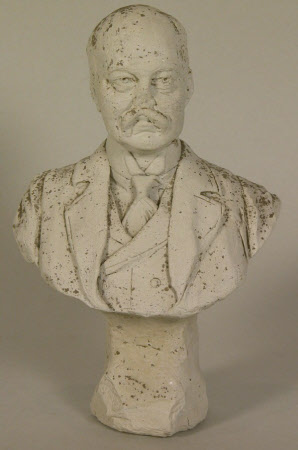Portrait bust of William Watson-Armstrong, 1st Baron Armstrong of Bamburgh and Cragside (1863–1941)
Alessandro Moretti (1870-1952)
Category
Art / Sculpture
Date
1904
Materials
Plaster
Measurements
190 mm (H)
Order this imageCollection
Cragside, Northumberland
NT 1230998
Summary
Plaster sculpture; portrait of William Watson-Armstrong, 1st Baron Armstrong of Bamburgh and Cragside (1863–1941); Alessandro Moretti (1870-1952); 1904. A small plaster portrait bust by Alessandro Moretti depicting the first Baron Armstrong, the heir of the childless Sir William Armstrong. This seems to be the plaster model from which a bronze cast could have been made.
Full description
A small model in plaster for a portrait bust of William Watson-Armstrong, 1st Baron Armstrong of Bamburgh and Cragside (1863–1941), by the Italian sculptor Alessandro Moretti (1870-1952). Lord Armstrong is shown, as in his painted portraits, formally dressed in a suit with a double-breasted waistcoat, and a winged collar. He has a large moustache. Signed on the back Moretti and dated 1904. The model has specks of paint and numerous small damages all over, including the nose which is lost, and the very roughly modelled socle. The plaster appears to be a working model, from which casts to be made in bronze could have been made. Moretti’s original portrait bust would have been made of clay, from which a mould would have been made, in which the plaster version would have been cast. It could have then in turn have served as the model for a bronze cast. The very sketchy socle perhaps suggests that this was included in the model for convenience in handling, and that any socle would have been separately made and atatched to the bronze bust after casting. Hitherto regarded as an anonymous portrait, comparison with the many photographs and portraits at Cragside, such as the oil painting by George Harcourt (NT 1230359), leave little doubt that the subject is in fact William Watson-Armstrong, 1st Baron Armstrong of Bamburgh and Cragside (1863–1941), who inherited the majority of his estate, including Cragside and Bamburgh Castle, from his childless uncle Sir William Armstrong. Raised to the peerage in 1903 as Baron Armstrong, of Bamburgh and Cragside in the County of Northumberland, Lord Armstrong shared his uncle’s philanthropic instincts but not his business acumen. It was as a result of his unwise investments and ventures that almost all the valuable paintings at Cragside had to be sold at Christie’s in 1910. The little portrait was formerly attributed to the Italian sculptor Giuseppe Moretti (1857-1935), who spent much of his career working in the United States. It is in fact by another Itaiian sculptor, Alessandro Moretti (1870-1952), who was born in Biella in Piedmont but grew up in Piacenza. In 1897 Moretti left Italy for Sweden, where he lived for much of his life. He enjoyed a successful international career, counting royal families among his many clients for his portraits. Although today he is all but unknown, he seems to have been relatively well-known in his lifetime. An article published in 1909 stated that ‘Throughout the continent of Europe, in buildings and in cemeteries, are Moretti’s sculptures, some of them important pieces, in the finest marble.’ (‘Portraits in Clay. A clever artist at Bingley Hall’, Birmingham Gazette and Express, 8 April 1909). Alessandro Moretti travelled very widely, to Germany, Sweden and even South America, but he seems to have lived in Britain for several years in the first decade of the twentieth century. He was especially known for his facility as a modeller and for his ability to fashion portraits with extraordinary rapidity, as can be seen in the bust at Cragside. The 1909 article in the Birmingham Gazette and Express in fact reported on an exhibition at Bingley Hall, Alessandro Moretti, lo Sculptore (‘Alessandro Moretti, the Sculptor’), that was designed as an opportunity for visitors to have their portraits made by Moretti on the spot. The writer described the sort of rapid modelling that may be seen in the bust of Lord Armstrong: ‘Out of clay his deft fingers, working skillfully and rapidly, fashion a likeness. Moretti is an artist to his finger-tips; indeed it is the tips of his fingers […..] that play the leading part in his work, for beyond his fingers he uses little, an old clasp pocket knife, and one modelling tool completing his outfit.’ According to the article, before coming to Birmingham ‘Mr. Moretti had been kept busy making busts, large and small, in London. […] he is able to speak of peers of the realm, an admiral, and some of the best kown professional and business men of the City of London, who have had their ”portraits in clay” taken by him.’ The bust at Cragside is the only work by Moretti currently known in a UK public collection. Jeremy Warren March 2022
Provenance
Presumably commissioned by William Watson-Armstrong, 1st Baron Armstrong of Bamburgh and Cragside; Armstrong collection. Transferred by the Treasury to The National Trust in 1977 via the National Land Fund, aided by 3rd Baron Armstrong of Bamburgh and Cragside (1919 - 1987).
Marks and inscriptions
On back, signature:: Moretti 1904
Makers and roles
Alessandro Moretti (1870-1952), sculptor Giuseppe Moretti (Siena 1857 - San Remo 1935), sculptor
